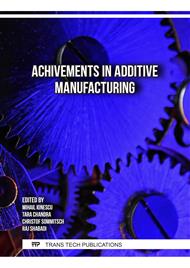[1]
L.D. Bobbio, Design of an additively manufactured functionally graded material of 316 stainless steel and Ti-6Al-4V with Ni-20Cr, Cr, and V intermediate compositions, Addit. Manuf., 51 (2022) 1-13.
DOI: 10.1016/j.addma.2022.102649
Google Scholar
[2]
I. Thomashchuk, D. Grevey, and P. Sallamand, Dissimilar laser welding of AISI 316L stainless steel to Ti6-Al4-6V alloy via pure vanadium interlayer, Mater. Sci. Eng., 622 (2015) 37-45.
DOI: 10.1016/j.msea.2014.10.084
Google Scholar
[3]
N. Özdemir, B. Bilgin, Interfacial properties of diffusion bonded Ti-6Al-4V to AUSU 304 stainless steel by inserting a Cu interlayer, Int. J. Adv. Manuf. Technol. 41 (2009) 519-526.
DOI: 10.1007/s00170-008-1493-6
Google Scholar
[4]
M. Ghosh, S. Chatterjee, and B. Mishra, The effect of intermetallics on the strength properties of diffusion bonds formed between Ti-5Al-2.4V and 304 stainless steel, Mater. Sci. Eng. A, 363 (2003) 268-274
DOI: 10.1016/s0921-5093(03)00649-x
Google Scholar
[5]
H.C. Dey, M. Ashfaq, A.K. Bhaduri, K.P. Rao, Joining of titanium to 304L stainless steel by friction welding, J. Mater. Process. Technol., 209 (2009) 5862-5870.
DOI: 10.1016/j.jmatprotec.2009.06.018
Google Scholar
[6]
G.B. Kale, R.V. Patil, and P.S. Gawade, Interdiffusion studies in titanium-304 stainless steel system, J. Nucl. Mater., 257 (1998) 44-50.
DOI: 10.1016/s0022-3115(98)00179-2
Google Scholar
[7]
Information on https://yorksheet.com/dissimilar-metal-welding/
Google Scholar
[8]
F. Akyel, S. Olschok, and U. Reisgen, Reduction of distortion by using the low transformation temperature effect for high alloy steels in electron beam welding, Weld. World, 65 (2021)23-34.
DOI: 10.1007/s40194-020-00993-1
Google Scholar
[9]
J.F. Smith, The Fe-V (iron-vanadium) system, Bull. Alloy Phase Diagr., 5 (1984) 184-194.
Google Scholar
[10]
J.C. Lippold and D.J. Kotecki, Austenitic Stainless Steels, in: Welding Metallurgy and Weldability of Stainless Steels, Hoboken, New Jersey, 2005, pp.141-229.
DOI: 10.1007/978-3-7091-8965-8_9
Google Scholar
[11]
T.E. Tietz and J.W. Wilson, Vanadium, in: Behavior and Properties of Refractory Metals, Stanford, California, 1965, pp.331-374.
Google Scholar
[12]
Y.M. Kozlovskii and S.V. Stankus, Thermal expansion of vanadium in the temperature range of 98-2400 K, J. Phys: Conf. Ser. 1677 (2020) 1-4.
DOI: 10.1088/1742-6596/1677/1/012167
Google Scholar
[13]
314L (UNS S30403), All Conditions, V.1, Database: JAHM Materials, Granta (information on https://www.jahm.com/)
Google Scholar
[14]
316L (UNS S31603), All Conditions, V.1, Database: JAHM Materials, Granta
Google Scholar
[15]
21Cr-6Ni-9Mn (UNS S21904), All Conditions, V.1, Database: JAHM Materials, Granta
Google Scholar
[16]
T.W. Nelson, J.C. Lippold, W. Lin, and W.A. Baelsack III, Evaluation of the Circular Patch Test for Assessing Weld Solidification Cracking Part 1 – Development of a Test Method, Weld. J., 76 (1997) 110-119.
Google Scholar
[17]
J.C. Lippold, Solidification behavior and cracking suceptibility of pulsed-laser welds in austenitic stainless steels, Weld. J., 73 (1994) 129-139.
Google Scholar
[18]
J.W. Elmer, S.M. Allen, and T.W. Eagar, Microstructural development during solidification of stainless steel alloys, Met. Trans., 20A (1989) 2117.
DOI: 10.1007/bf02650298
Google Scholar



